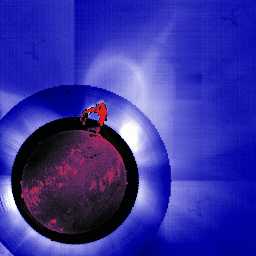

Coronal mass ejections (CME's) are dynamic events in which plasma which was initially contained on closed coronal magnetic field lines is ejected into interplanetary space. These events are daily occurrences, averaged over a solar cycle, and involve significant masses, typically 1015 to 1016 grams, and mechanical energies on the order of 1031 to 1032 ergs. The disruption of what might be regarded as a stable, magnetically-closed structure poses fundamental questions in the field of magnetohydrodynamics (MHD).
In practical terms, an improved understanding of mass ejections is also important, since they are known to play a major role in non-recurring storms in the Earth's magnetosphere and ionosphere, which in turn are responsible for enhanced auroral activity, satellite damage and some power station failures. Mass ejections create these disturbances by driving interplanetary shock waves and accelerating particles to relativistic speeds, all of which come "crashing" into the earth's magnetic environment. [see Gosling et al. (1974), Rust (1983), Sheeley et al. (1985), Schwenn (1986), Cane et al. (1987), Feynman and Garrett (1987), Kahler (1994), Bravo and Perez-Enriquez (1994), McAllister et al. (1996a), Weiss et al. (1996), Reames et al. (1996)]. An example of a CME is shown below in Figure 1.
Figure 1: A superposition of white light and Hydrogen-Alpha (H-alpha) images showing the structure of a coronal mass ejection observed from space and the ground on 5 October 1989.
White light images of the outer corona were recorded by the Solar Maximum Mission (SMM) orbiting coronagraph (C/P); the inner corona was recorded by the K-Coronameter (Mark-III) at the Mauna Loa Solar Observatory (MLSO).
The red image extending outward from the solar limb is from the Mauna Loa H-alpha prominence monitor, and it shows an eruptive prominence extending well out into the corona. The innermost red H-alpha limb and disk image are courtesy of the Space Environment Center (SEC) of NOAA and were taken approximately two hours before the prominence erupted.
The sun has been a primary suspect as a cause of geomagnetic activity for many decades [Chapman and Ferraro (1931)]. Early studies of the sun revealed that structures known as prominences (called filaments when seen on the solar disk) were likely being ejected into interplanetary space [Pettit (1932), Pettit (1940), Bjerke (1957), Valnicek (1964)]. Mass ejections have been observed in coronagraph and coronameter instruments for ~25 years [for early observations see: Tousey et al. (1974), Hansen et al. (1974), Brueckner (1974), Hildner et al. (1975a)].
Basic properties, such as morphology, location, width, speed, acceleration, and mass, were determined by observations from instruments on OSO, Skylab, Solwind, SMM and from the Mauna Loa K-Coronameter (Mark-III). [References: Hildner et al. (1976), Gosling et al. (1976), MacQueen and Fisher (1983), Munro and Sime (1985), Howard et al. (1985), Howard et al. (1986), Hundhausen (1993), Webb & Howard (1994a), Hundhausen et al. (1994a), and Hundhausen et al. (1994b)].
Reviews of the origins of coronal mass ejections and their relationship to other forms of solar activity are given by MacQueen (1980), Wagner (1984), Hundhausen (1987), Kahler (1987) Forbes (1991), Kahler (1992), Webb et al. (1994b), Low (1996), and Hundhausen in press (1997).
To understand the cause (or causes) of CME's, it is necessary to determine the precise sequence of events that lead to the eruption. Studies of `associations' have been undertaken to identify the relationship between CME's and other solar activity. While the cause(s) of CME's has not been determined, there is general agreement on several points:
Figure 2: This prominence was photographed in June 1946 through a filter centered on the emission line of neutral hydrogen known as hydrogen alpha (or H-alpha).Prominences extending so far above the photosphere are usually not static, but are expanding outward in an eruptive phase. The bright arch at the bottom of the picture delineates the solar limb. This image is one of twenty images compiled by Dr. Paul Charbonneau and Dr. Oran White and offered as a Pictorial Introduction to the Sun.
While some forms of activity such as filament eruptions are highly associated with mass ejections, there is no form of activity that has a one-to-one correspondence with mass ejections. There are examples of all types of associated activity that have been recorded without the detection of a mass ejection, as reported by Kahler (1987). Accurately identifying the sequence of events leading to mass ejections and their associated activity will resolve some of these ambiguities.
During the 1990s, several satellites have been successfully launched and are returning new information about the sun and the solar wind. The Ulysses Spacecraft was launched in October, 1990, from the Space Shuttle Discovery (Mission: STS-41C) and is now orbiting the sun in a polar orbit, providing the first in situ measurements of the solar wind at high latitudes. The WIND spacecraft was launched in November, 1994, and is in a halo orbit at the Earth-Sun L1 point. It measures the plasma parameters of the solar wind upstream from Earth, providing input for magnetospheric and ionospheric studies and geomagnetic storm forecasting.
Launched in December, 1995, the Solar Heliospheric Observatory (SOHO) includes instruments such as the Large Angle Spectrometric Coronagraph Experiment (LASCO) that provide white light images of the corona out to 30 solar radii, and the Extreme ultraviolet Imaging Telescope (EIT) which records the solar disk and low corona over the limb in ultraviolet light. SOHO and WIND are part of the International Solar Terrestrial Physics Program (ISTP). These and other exciting new data will provide some of the information necessary to answer some of the long standing questions about coronal mass ejections.
The Mauna Loa Solar Observatory (MLSO) is operated by the High Altitude Observatory (HAO), a division of the National Center for Atmospheric Research (NCAR), and funded by the National Science Foundation (NSF).
© 1998 NCAR
![]() Return to MLSO CME
home page
Return to MLSO CME
home page
![]() Return to SMM C/P CME
home page
Return to SMM C/P CME
home page
